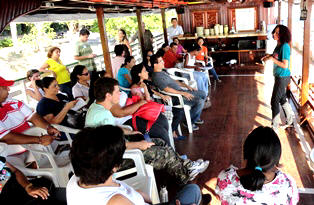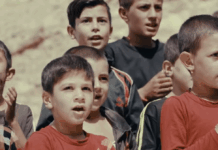By Jerry Wiles

“Immediately he received his sight and started following Jesus”, Scripture says, of the blind beggar known as Bartimaeus (which means son of Timaeus), as recorded in Mark chapter 10.
The story of the blind beggar is one of the five stories used in Living Water International’s basic Orality Training Workshop.
A woman who attended a workshop was legally blind. She learned the story of Bartimaeus, the blind beggar. The night of the first day of training, the woman was at home reflecting on the story. She said she closed her eyes and said, “Lord, I believe! Lord, I believe!” When she opened her eyes, she could see. The next morning in the second day of training, the woman shared her experience with all the group. There was much rejoicing for everyone to realize that Jesus is still able to give sight to the blind today, both physically and spiritually.
When we consider the background, context and content of the healing of Bartimaeus, we see that it contains much truth and many lessons. This takes place toward the latter part of Jesus’ ministry and life on earth. He often taught His disciples important lessons while traveling on the road.
Jesus had been talking to the disciples about the importance of having a servant’s heart and attitude. He was giving them principles of servant leadership. In fact, He told them that the Son of Man came, not to be served, but to serve others. He taught them that if one wants to be great in God’s Kingdom, he must learn to be the servant of all.
After learning this story, trainees are asked such questions as, “What do we learn about the people’s attitude toward this blind beggar?” “What do we learn about who Jesus values?” “What do we learn from the fact that the blind beggar threw off his coat to come to Jesus?” There are many lessons in the story about faith, prayer, and being persistent and specific in our requests of God.
In many of the countries where Living Water International works, beggars and blind people are much more common that in North America or the Western World. These people are able to relate to the context of the story and make applications to their own lives. They discover many profound insights.
Additional questions for discussion might be: “What do we learn from the fact that, after the blind man received his sight, he started following Jesus? Is there a lesson in this for us? Is there a spiritual lesson and application? What do people do when they are born again, born of the Spirit and receive their spiritual eyesight?” People often come to the conclusion that it is necessary for one to receive spiritual sight in order to truly follow Jesus.
Orality training participants are able to spend hours discussing short, simple stories when the right questions are asked. The questions about the stories are usually from the following three categories: From the story, what do we observe? What does it mean? And, how does it apply to our lives? People are always amazed at how much they can learn from just a few simple stories. The focus on learning a little, practicing a lot, implementing immediately and telling the stories often has a powerful impact. People respond well to the emphasis on, not learning a large number of stor ies, but learning a few stories, that they tell to a large number of people.
Oral cultures learn in community, so they have the benefit of the collective memory of the group. When people learn stories well and discuss them often, they tend to tell them to others and the message is spread quickly. Reproducibility and multiplication are important factors in the orality movement.
Once pastors, evangelists, missionaries and church planters gain a better und erstanding of orality, they are energized with new vision and passion. A pastor in South Asia told of how he had been using biblical storytelling to present the gospel for many years. After participating in LWI’s OTW, he shared that what had been missing in his previous approach was the reproducibility. He recognized that with more repetition and engagement, it was more reproducible. He said, “From now on, I’ll use this method.”
A pastor in Central America said, “Now I see that with this method, I can equip, train and mobilize story-telling evangelists at every level of age and education.”
According to Mark Snowden, they (oral learners) are probably the least evangelized group in the nation (Mark Snowden, Orality: The Next Wave of Mission Advance, International Journal of Frontier Missions, Jan-Feb 04). He says that if we are serious about reaching the people of this generation who are not yet Christians, we must give ourselves to understanding how they communicate and learn, and develop skills for bringing the Messag e to them. It is estimated that over 90% of all preachers of the gospel have been trained to communicate only to literates using an analytical format, which oral learners find nearly impossible to relate to or remember. Outlines, steps, principles, lists and similar constructions assume literacy. Within oral cultures people do not learn and retain their understanding of truth and life in these ways.
——————————————————————————–
Jerry Wiles serves as president emeritus of Living Water International (http://www.water.cc) Living Water is one of the world’s leading faith-based water solutions organizations with operations in Asia, Africa, and Central and South America. Having gotten involved in orality-based evangelism and disciple making strategies in the 1980s, he has been a paradigm pioneer in the orality movement and presently serves on the advisory council of the International Orality Network. Wiles has more than 35 years experience in ministry and international mission work. He can be contacted at [email protected]



